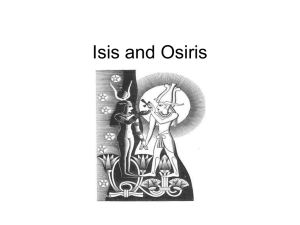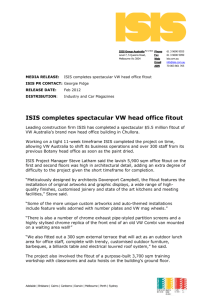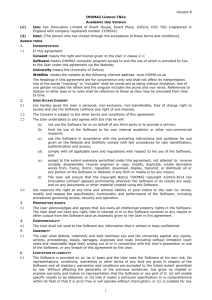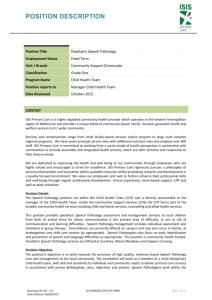Kelly Guerrieri - The cult of Isis in Pompeii, 9:40
advertisement
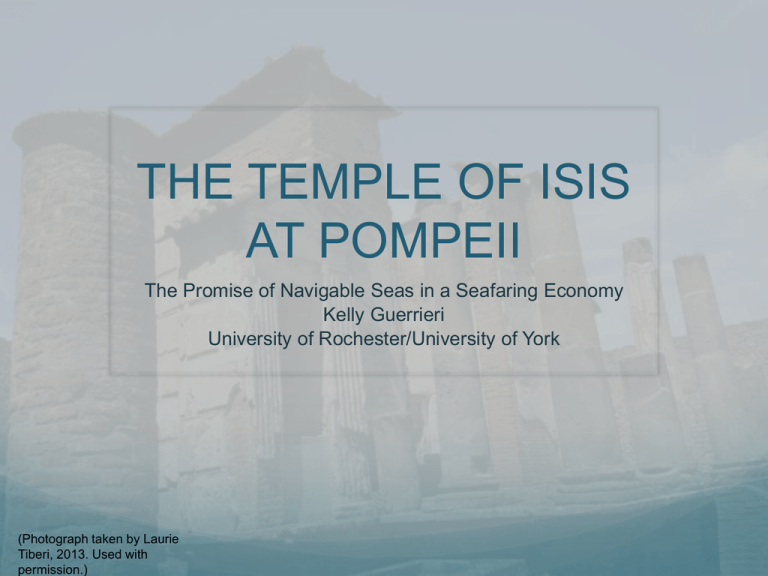
THE TEMPLE OF ISIS AT POMPEII The Promise of Navigable Seas in a Seafaring Economy Kelly Guerrieri University of Rochester/University of York (Photograph taken by Laurie Tiberi, 2013. Used with permission.) Left: (Wild 1981, 45) Above: (ARTstor, R40171745) What’s so special about this temple? “Numerius Popidius Celsinus, son of Numerius, rebuilt at his own expense from its foundations the Temple of Isis, which had collapsed in an earthquake; because of his generosity, although he was only six years old, the town councilors nominated him into their number free of charge” (ILS 6367) Mystery cults vs. state religion Isis versus Neptune Why should I care? Pompeii’s economy: commercial seafaring Isis = stable, life-giving water Defeat of the treacherous, unpredictable, and sometimes deadly sea (Neptune) Architecture, art, and evidence of the secret rituals reveal importance of cult of Isis in Pompeii The relatively gentle Isis, offering resurrection and regulated water, must have seemed a comforting counterbalance to the unpredictable Neptune. The Game Plan Pompeii and the Sea Navigium Isidis The Nilometer – Structure, Function, and Symbolism Artwork – Nilometer, Portico, Ekklesiasterion Pompeii and the Sea “Given its position on the Sarno, on which merchandise travels in both directions, Pompeii serves as the port for Nola, Nuceria, and Acherrae” (Strabo, Geography 5.4.8.) (http://www.mariamilani.com/rome_maps/pompeii_vesuvius_map.jpg) An Observer’s–Eye View of the Navigium Isidis (http://eusebeis.files.wordpress.com/2012/09/navigiumisidis.jpeg?w=800) Navigium Isidis “Another bore in his happy bosom the revered image of the highest deity, in a likeness not of an ox or bird or wild animal, nor even of a man, but inspiring reverence both through its skilled workmanship and by its very strangeness, it was an unutterable witness to a faith ever lofty which claimed to be hidden in a vast silence. It was fashioned of gleaming gold in the following form: a small vase it was, most cunningly hollowed out, with a base finely rounded, while outside it was adorned with wondrous Egyptian figures. Its mouth was not so high and stretched to a channel, standing out in a long spout; on its other side was a handle turning well away and joined in a sweeping curve. On top of the handle was set an asp in a coiled knot, its scaly neck rearing itself with a streaked swelling.” (Apuleius of Madauros 1975, 83, 85.) An Observer’s–Eye View of the Navigium Isidis (http://eusebeis.files.wordpress.com/2012/09/navigiumisidis.jpeg?w=800) What’s with the boat? Not a ritual model (although appears so in the picture!) Meant to sail and trade Loaded with hand-picked crew and tradable goods Set to sail to mark opening of sailing season Symbol of Isis’s power to guide navigation and calm seas The Nilometer (Wild 1981, 45.) (ARTstor, R40171763) Structure Southeastern corner of temple complex Nile is southeast of Pompeii – intentional positioning? Small, narrow, not elaborate Enter and descend to water crypt – basin with no drain Low and vaulted Symbolism Nile flood recreation Power of the Egyptian gods Rainwater sacred Collection site for water for daily libation rituals Possibly location of initiation rituals – involved water Beginning of initiate process = the priest “led me [Lucius] with an escort of the faithful to the baths at hand and first submitted me to the customary ablution. Then he prayed for the forgiveness of the gods and besprinkling me cleansed me most purely.” (Apuleius 1975, 99.) Function Rainwater collection Recreation of Nile flood Site of ritual “drowning”? Initiation ritual brought initiate to “the boundary of death” and “through all the elements”, personal experience of gods, death, and resurrection (Apuleius of Madauros. 1975. The Isis-Book (Metamorphoses, Book XI). Translated and edited by J. G. Griffiths, 99. Leiden: E.J. Brill. ) Salditt-Trappmann: “individuals entered the basins in these crypts to undergo a ritual drowning” (Wild, R.A. 1981. Water in the Cultic Worship of Isis and Sarapis, 52. Leiden: E.J. Brill. ) Artwork in the Nilometer Sacred cultic pitcher in fresco above entrance, adoring figures surround (Wild 1981, Plate VI.1) What’s with the pitcher? Isis associated with water, especially Nile Isis and Osiris myth Osiris Hydreios (Osiris in a jar) Giver of life Cultic pitchers began to replace Nilometers Pompeii is the only place where we have evidence of both a Nilometer and cultic pitchers at the same time! Herculaneum Fresco (http://www.bbc.co.uk/history/ancient/romans/images/gal_daily_isis.jpg) Perseus and Andromeda, what are you doing here? Mixing Roman and Egyptian themes? Perseus overcomes a wild sea – good for Pompeiians! (Wild 1981, Plate VI.2) (ARTstor, R40171749) Portico and Ekklesiasterion Portico: Lots of ships! Isis = patroness of sailors Also images of priests and cult members Ekklesiasterion: Images of Isis and Osiris myth, Jupiter and Io Rented out to city for events Juxtaposition of Egyptian and Roman religious myths (ARTstor, “Temple of Isis; Isis receives Io in Egypt”, 10-04-03/56) In Summary: Isis was associated with water, especially the gentle and lifegiving waters of the Nile. She promised seafaring navigability (along with many other benefits) in exchange for personal devotion. Neptune was the unpredictable god of the sea. Pompeiians needed the sea to be navigable. They were aware of Isis’s power through the Navigium Isidis and the decoration of her temple. Therefore, the Pompeiians supported the rebuilding of the Temple and the popularity of the cult in order to ensure the safety and prosperity of their sea trade. Top left: (Metropolitan Museum, “Bronze Statuette of Neptune”, 07.286.93) Top right: (ARTstor, “Isis”, 10-02-02/28) Center: (Photograph taken by Laurie Tiberi, 2013. Used with permission.)

